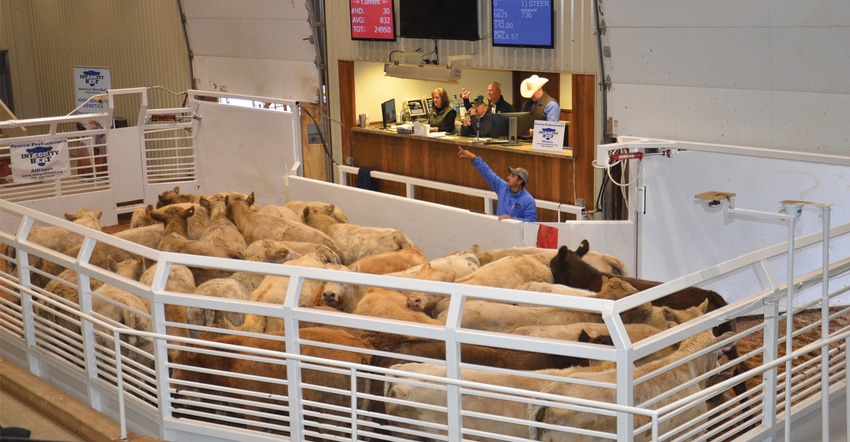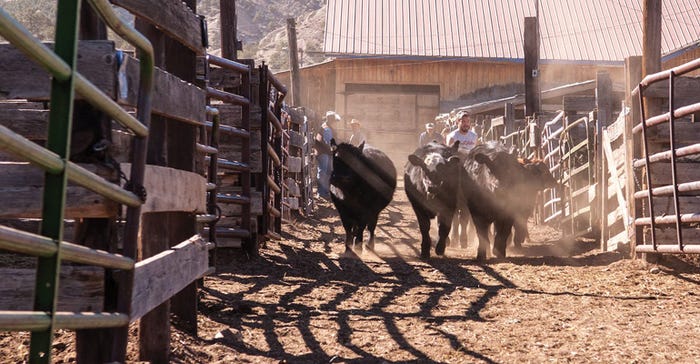How to market cattle to maximize value
Marketing is often one of the most difficult parts of running a beef operation. Here’s a look at some marketing options.
September 23, 2019

Editor’s note: In conversations with BEEF readers who have been in the cattle business for years, one thing stands out — a concern for people who are entering the business. To address that concern, BEEF will feature a series of articles over the next year written by veteran contributor Heather Smith Thomas that look at various aspects of ranch management. While these articles will focus on the basics, it may be that old-timers can pick up a tip or two as well. This is the third in the series.
Many producers do a good job of raising calves, taking care of cattle and keeping them healthy. Marketing, on the other hand, is often the most challenging part of their program, reducing potential profit.
It can be challenging to market cattle at optimum times. There are many ways to market calves, yearlings and cull cows or bulls, but we don’t always market them strategically — or with the least cost.
Thus, when developing a marketing strategy, look for the gap in supply — a time of year when supply is down and markets are up, says Bart Lardner, Western Beef Development Center, and a professor in the Department of Animal and Poultry Science of the University of Saskatchewan. Most calves and cull cows are sold in the fall at weaning time, and prices tend to drop.
However, many people don’t have the flexibility to market cattle at the best times because of their management program — with certain times of year for calving and weaning, and needing to use certain pastures at a certain time. Some operations are locked into a certain system, and that may just be part of the cost of marketing.
“You don’t want to put more feed in animals to hold them longer [hoping for a better market later] if your grass is gone,” says Joe Stookey, cattle producer and a recently retired professor at the Western College of Veterinary Medicine, Saskatoon, Saskatchewan. “The market might be better two months from now, but you’d need more feed and a place to put them if you hold cattle that long.”
It may also hinge on how and when you wean calves, and how you minimize stress and shrink. “Some people are leaving calves on the cows a little longer, or calving later. October may not be the month of weaning; some are going into December or later, letting calves stay with their mothers on swath grazing. This may spread out marketing, so there’s not such a glut of calves being sold all at once,” Stookey says.
Marketing calves and yearlings
If you have some management flexibility, maybe you can alter your program and market a different time of year, when prices are higher. Some producers background their calves to sell as stockers the next spring, or in July-August, when there’s more demand and higher prices. Whether or not you can do this, however, depends on feed resources available or price of feed to winter the calves.
For maximum return, stockmen should start the year before with a breeding program and calving season to fit how they plan to market calves — whether through an auction yard, order buyers, video sale or combination of markets, says C. Wilson Gray, retired Extension economist at the University of Idaho. Taking calves to an auction or selling through an order buyer at the ranch usually means depending on the market at delivery time, which makes the final price less certain.
Some producers sell calves at weaning or after a few weeks of preconditioning after weaning. “With video auctions, they may contract calves ahead of weaning — such as in spring or summer — for fall delivery. This takes some of the guesswork out, but other factors include trucking. You need to know how far the cattle will be trucked and what that cost will be,” says Gray.
Others precondition calves to take advantage of premiums offered or to avoid discounts on calves sold right off the cows. “Some hold calves until the prices strengthen after the first of the year — or into the next summer, to sell as yearlings. If they can add additional weight economically, this can be profitable,” he says.
If light calves are worth a lot, however, and feed resources are in short supply or costly, it may pay to sell at a younger age. Another factor is the kind of preconditioning program calves have been through.
If feedlots know the cattle from a certain operation perform well, they are willing to pay more. These cattle get off to a better start, with fewer health problems, Gray says.
Many feedlots spell out the type of preconditioning program they want for calves. “This might mean weaning and holding them for three or four weeks, up to a couple months, before they go to the feedlot,” he explains.

Marketing strategically
It’s challenging to run a business with only one or two paychecks per year — when calves are sold, and then cull cows or bulls — so some producers create multiple paydays with strategic marketing.
That may be both a spring-calving herd and a fall-calving herd. Some producers keep all their heifers, expose them to a bull for a short breeding season and then preg-test — selling any that didn’t breed as open heifers on a good yearling market.
“Some marketing programs are administered by the Ag Marketing Service [USDA] which sets up parameters like source and age verification; or selling into grass-fed, organic or natural-produced markets,” says Gray. “You need to know what you have to do to sell with that kind of label.” This takes extra planning and possibly more expense.
Typically, you’ll need records to show source, age, how the cattle have been managed for health and other management practices. There may be a fee to be part of one of these programs. A producer must weigh all costs and benefits to see if the premiums involved in a program more than offset the costs and extra effort.
“There are cooperative marketing systems in which you must be a member to sell your cattle that way, and follow guidelines to meet their standards, but they have a dedicated market,” says Gray. There are increasing numbers of organizations and niche markets that producers can use.
“Some ranchers raise certain types of cattle to fit a particular market like grass-fed, or the Certified Angus [Beef] program. The Angus folks have done a terrific job of marketing. If the animals meet the qualifications, they make those premiums.”
Calculate your costs
If you send cattle to an auction, trucking costs and commissions must be figured in. “If you have a pickup and trailer, you are looking at least $2 per loaded mile to haul cattle [one way]. If a trucking company takes them to a feedlot, you need to have at least 45,000 pounds on that truck — because you can’t afford to send a part load, with the cost of fuel today,” says Gray.
If a person doesn’t have enough to make a load, neighbors often pool cattle to make up loads. Sometimes a video auction will put together two or three small outfits to make a load.
There are commissions and fees to market cattle, whether through a video auction or sale yard. If you take cattle to a sale yard a day or so before the sale, there will also be feed and yardage costs on top of the regular commission.
Some producers retain ownership until cattle go to slaughter, growing them on grass or sending them to a custom feedlot. “Those decisions must be penciled out. There is also a definite seasonality to prices, and they vary a little by weight category,” Gray says.
“If calves come off desert range and are light, there’s almost always a good spring market for lighter calves to put on pasture. If the rancher can make the right connections, it may pay to fit into a situation like that. In Oklahoma and North Texas, if conditions are right, many cattle are put on wheat pastures over winter. People are looking for the right kind of animals to go into those programs,” he says.
“Often, traditional marketing gives you some kind of return, but there may be something you can do differently and make more money, or there may be a program that part of the animals fit into to give a higher return, rather than just doing it the way you’ve always done,” Gray says. It may pay to sort cattle and sell them more strategically in different groups.
Some producers cut out the middleman entirely by raising calves to slaughter age, finishing on grass or grain, and marketing the meat themselves. This takes planning, using a federally inspected slaughter facility, and developing a customer base.
Marketing cull cows and bulls
Sale of cull animals is a big part of a producer’s cash flow. “It’s not just about marketing calves wisely, but also the culls,” says Lardner. “It helps if you can hit the higher prices on them, too. If you preg-check in September or October, it may be prudent to hold open cows until after prices strengthen in January — if you have the feed. The cull cow market usually bounces back up when the supply is lower,” he says.
Keeping animals longer isn’t always profitable, however. “The cost per day of keeping them can surprise us. Everyone must look at their own costs and take advantage of opportunities,” he says.
Marketing cows off-season can pay. “Whenever our cows come past a corral, there’s opportunity to pull some out to sell if we know which ones won’t be kept. If we market those sooner, we have less feed cost in them. Much of whether we sell at a profit or loss is in not incurring additional cost of feed or having a well-thought-out placement in the market when cattle prices are higher,” Lardner says.
“Maybe you’ll have a truckload of cows with good body condition that can be marketed smartly, but keeping them longer comes down to whether they will gain weight profitably. Older cull cows might not recover lost weight as readily as younger cows.”
Auction yards
Local auction markets provide an essential service, taking all kinds of cattle. Whenever you can get buyers together, bidding competitively on your cattle, you’ll get a better price than if you only show them to one buyer who comes to your operation.
Auctions are where you’ll sell cull cows and bulls; butcher cattle are not sold through the video markets. With the price of fuel, a person can’t afford to haul cattle very far, especially with just one or two animals instead of a trailer load.
Generally, an auction works hard to get buyers, so cattle bring what they’re worth. Ranchers don’t have to rely on their own knowledge of the market. Even country buyers don’t know what cattle are worth at any given time unless they see an auction report.
No matter what kind of operation you have, there will be some extra calves or some that don’t fit a particular load. The local sale barn provides a market for every class of cattle, from weaned calves to bulls or cull cows. Special sales play a key role in attracting buyers and sellers. Whether for age-and-source-verified calves, natural cattle, Certified Angus Beef or preconditioned cattle, the buyers know they can go to that sale and get what they need without driving miles and miles around the country.
Smith Thomas is a rancher and freelance writer based in Salmon, Idaho.
About the Author(s)
You May Also Like


.png?width=300&auto=webp&quality=80&disable=upscale)
